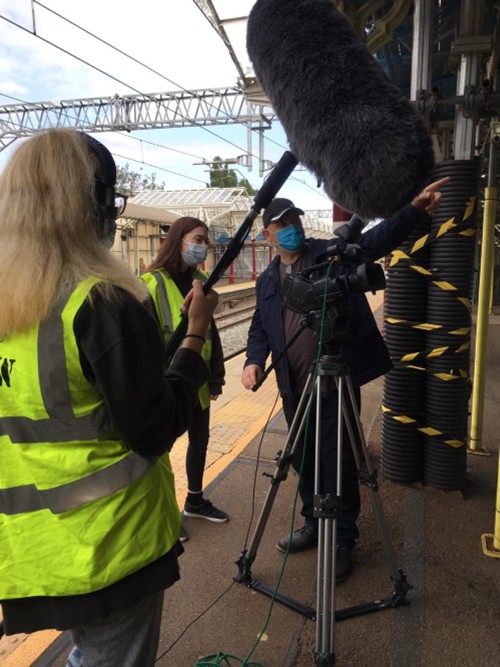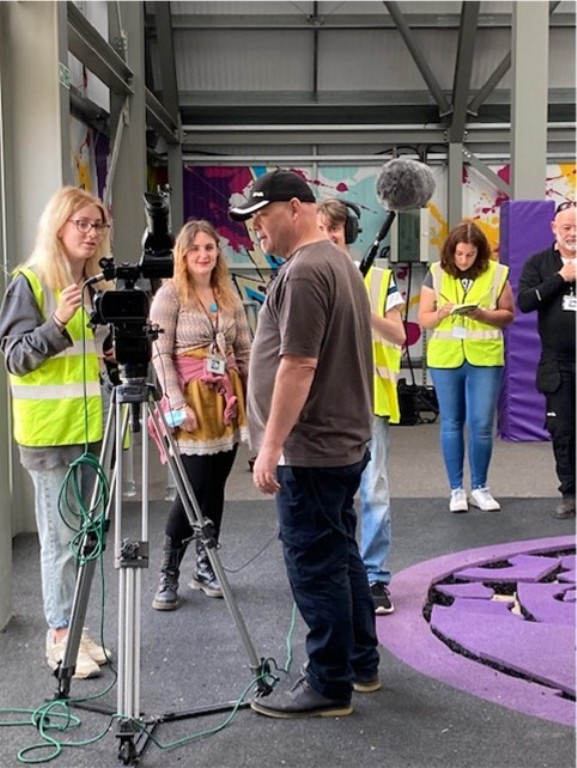|
AND FINALLY
A NEW SMALLER VERSION OF THE KETTERING
MOSAIC
HAS BEEN MADE AND INSTALLED IN THE
Alfred East Art Gallery
AND THE STORY HAS BEEN DOCUMENTED ON
FILM
The Lost
Mosiac
(The DVD is now available @ £10 + p&p - contact the
secretary)
After 20 years the biggest community
project by Kettering Civic Society has SUCCEEDED!
Over the years so many people have
contributed towards preserving the historic mosaic that records and provides
a memory of Kettering’s past.
On 5th January the new smaller mosaic, paid for through public sponsorship -
was installed at the Alfred East Art Gallery.
The story behind the abstract images have
been documented in a film that is being created by UK Film School and paid
for by Historic England through Kettering Cultural Consortium as well as
further sponsorship. Appearing in the film is actor Victoria Wicks, Ian
Addis, former headteacher and local author/historian and Oliver Budd the
mosaic artist, Charles Lister from Boughton House, Northamptonshire - not to
mention Civic Society members!
Our list of credits will be long and can be
seen when the film is premiered in the Odeon in the spring.
We give huge thanks to the following for yesterday:
-
NNC for helping to find a suitable
place for the mosaic, to NNC staff, Rob and his team for allowing us to
film and use the fabulous new facilities.
-
To the gallery staff for allowing us to
film whilst they were busily working hard to hang an exhibition which
coincidentally is ‘Art in the High Street’ which is also funded by
Historic England. We look forward to seeing the gallery when it opens
soon.
-
To the Cytringanians (The former
Grammar School Boys) for sponsoring hospitality for the crew.
-
To Cafe Bloc for hosting us.
-
To Gary and Robin @ukfimschool,
volunteer crew Nathan and Bobby.
-
Special thanks to Victoria who
travelled from London and Oliver who travelled from Kent.
All in all, a hugely successful and
fantastic experience with a very happy ending!





The Kettering
Mosaic Explained
Each area of the Mosiac has an exciting mixing of surfaces
and colours to create variety within the limits of individual forms and to
portrays the Coat-of-Arms and Industries of Kettering.

On the top left: A crown standing on its rim of ermine (1). The original
Grammar School was founded during the reign of Elizabeth 1, and this reminds us
of that foundation. On the crown are crosses and this same cross you will find
in the centre of the Coat-of-Arms of Kettering. Beneath the crown and moving
across there is: The Griffin (2) with his wings outstretched and straight from
the Coat-of-Arms except that his upper wing suddenly changes into coat sleeves
(3) illustrating the local tailoring industry, made clearer by the addition of
the shears. Underneath our Griffins beak there are a pile of boxes (4) depicting
the local carton manufacturers, and next across (5) the mouths and clappers of
two bells, reminding us that Kettering once had a Bell Foundry. Above the bells
is the Hide from the Coat-of-Arms (6), and over this three wheels (7) for the
Printing Industry, printing Braille (8) and Tickets (9). Between these we find
Flames (10) from the Coat-of Arms and indicating the Ironstone furnaces.
Alongside, and still moving to the right, are two Martins on "Fountain
Ground" (11) taken from the Coat of-Arms, and brought together for company.
Underneath them, the open upper of a boot (12) which I certainly could not omit,
and which echoes the wing shape of the birds. Whilst right at the bottom, the
shapes of Chains (13) leading round to Negroes in their white gowns (14).
Although only one Negro appears on the Coat of-Arms, 1 have used five, to remind
us that the Baptist Missionary Society founded in Kettering, was largely
responsible for the release of slaves. Hence our slaves wear their Baptismal
gowns. Three wear earrings, and two hats and if you look carefully, you will see
that they are not without features. The little motif in the bottom right-hand
corner is 62 for the year, and between the numbers - a bud! - it is the work
of Kenneth Budd
The making of the Kettering Mosaic
documentary


From the Secretary’s Diary
16th April phone call to ask Ian Addis if he would write the script
20th April mosaic cartoon delivered to Monica from Oliver Budd
26th April phone call with Gary; emailed Ian to arrange a meeting
27th April Meeting with Gary and Jacqueline at Ecton to discuss the timeline
of the project
30th April phone call with Ian
7th May Meetings with Gary, Ian and Monica at Ecton to decide the content of
the documentary.
15th May Email to Kettering Museum and Gallery- filming not possible due to
closure because of building works and restoration. Look into possibility of
filming at Boughton House.
PowerPoint presentation including photos prepared by Monica to assist with
the script and content of the documentary with suggested places to film.
13th May Phone call to Victoria Wicks to ask if she would take part in the
documentary. YES!
6th June Zoom meeting with GaryHalliday and Jacqueline Edge of the UK
FilmSchool
24th June Phone call with Ian
6th July Phone call with Gary. Discussion regarding recruiting Film School
students. Several enquiries, emails and phone calls as premises are sought
for recruitment. Non materialised due to covid restrictions, costs and lack
of suitable venues. Success in recruiting came from a video on 9th June when
details posted on social media by the UK Film School and Kettering Civic
Society’s article in Northants Newspaper. Potential students were
interviewed by Gary and 7 were recruited. One student found out about the
project through her parents visiting ARTworks and a chat with Monica
about the search for potential students.
9th July Meeting arranged with EMR to discuss permission to film at the
station and the use of rooms as a base throughout the 3 days filming.
Permission was sought to place an information board under the H.E. Bates
blue plaque. Gary completed the necessary safety documentation. Permission
granted for the use of the 1st Class and 2nd Class waiting rooms for
filming. Permission to use a room as a base for the film crew. Permission
granted-Station Master’s Office.
10th July Draft script completed by Ian
12th July Design and have an information board made about the H.E. Bates
blue plaque at the station. Details sent to Kensigns.
13th July phone Gary with the Getty Cultural Consortium image and other
logos. Introduced Gary to Anna the social media coordinator.
14th July email Gary regarding the filming of the mosaic cartoon
15th July Contacted Tracey Clarke Community and Heritage Manager at
Wicksteed park asking for permission to film the mosaic cartoon in an empty
building.
16th July Gary & Jacqueline to meet Charles at Boughton House, who agreed to
talk on camera with Victoria.
19th July Wicksteed Park okay for filming. Phone call from Gary.
23rd July 7 letters written and delivered to cafés and supermarkets
requesting sponsorship for catering during filmmaking.
27th July Northants Newspaper article re. filming
29th July The Kettering Rotary Huxloe Club sent email offering to sponsor
the catering. Viewed the empty building at Wicksteed park which is in need
of clearing and making safe.
30th July 10am Wicksteed Park with brush and shovel in preparation to clear.
Great surprise to be joined by 10 volunteers from Nationwide to help. The
dusty work took 2 ½ hours to complete. Problem where to lay out the mosaic
cartoons for filming to avoid the holes in the floor and also to cover over
the black surface so that the mosaic cartoons could be seen. Solution-
purchase plastic sheeting and make a frame with 5-foot canes to make a frame
measuring 15 feet x 45 feet. Finished at 4pm.
1st August bought food for 2nd August
2nd August 7.45am leave home to collect student from Corby. 8.45am Kettering
station for health & safety briefing, signing in etc. Introduction to
station, Time Travellers used as base.
1pm Wicksteed Park, filming and lunch. Shooting of the mosaic cartoons being
laid out. 5pm wrap Drove student to Corby. Shopping for lunch
3rd August 9am crew meet at Boughton House Filming until 1.30pm Lunch at
station Filming around the town 5pm Wrap Shopping for lunch
4th August 9am meet at station, one group filming Victoria getting on/off
train to Wellingborough and at station. Another group filming at the art
gallery, council offices, and William Knibb plaque, Chesham House. 12pm
lunch at station 1pm filming at Green Lane shoe factory, Kino and art
gallery. Filming ended at 5pm
5th August Mete and Monica return to remove and roll up the mosaic cartoons
at Wicksteed Park.
Thanks were sent via Emails to Tracey at Wicksteed Park, Charles at Boughton
House, Kettering Huxloe Rotary, Ian Addis and Victoria Wicks, Gary and
students.
|










